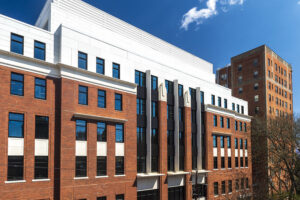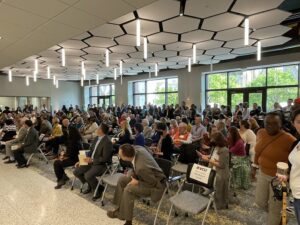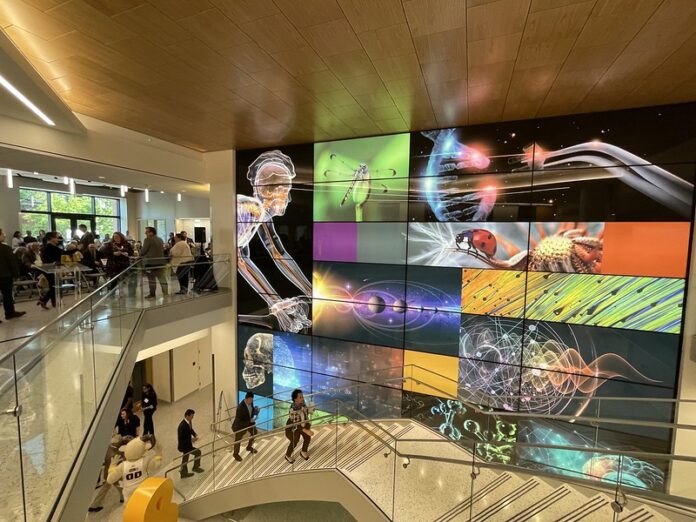A Virginia Commonwealth University forensic science major had to set up a murder scene, fake body included, for a class assignment. Her team met to prepare the scene on a Saturday morning. What they did not anticipate was their homework running into the Richmond marathon race, which draws thousands to city streets.
“We had a fake body on the ground and people were running by giving us all kinds of looks,” said Jaelyn Jenifer. “But it’s good to work in the elements, it prepares you for the real world.”
Now Jenifer and the approximately 400 other forensic science majors at VCU will have a state of the art crime scene lab space with movable walls to create crime scene variations.
VCU students, faculty and employees recently toured the new, 168,000 square-foot STEM building that has risen from the former Franklin Street Gymnasium. A crowd of curious onlookers came out for the April 26 ribbon-cutting of the new home for science, technology, engineering and math studies.
It stands as a beacon in the middle of the Monroe Park campus; a gleaming white, six-floor building to be primarily used by the College of Humanities and Sciences.
Nearly 60% of VCU undergraduate students are enrolled in the college’s 17 departments, as well as the Richard T. Robertson School of Media and Culture and School of World Studies. Approximately 10,000 students will take more than 70 STEM courses in the building each semester, in addition to other courses, according to a VCU press release.
 The new building officially opens for classes in the fall semester. There are two, 250-seat classrooms, 32 teaching labs, computer labs, wet and dry labs and an overall design emphasis on fluidity and collaboration. The larger classroom design moves away from lecture seating toward an interactive style format. There are also small-capacity flexible classrooms.
The new building officially opens for classes in the fall semester. There are two, 250-seat classrooms, 32 teaching labs, computer labs, wet and dry labs and an overall design emphasis on fluidity and collaboration. The larger classroom design moves away from lecture seating toward an interactive style format. There are also small-capacity flexible classrooms.
The VCU Math Exchange facility will move into the building, while some other departments will commute between buildings. The sixth floor will also fully house the college’s Department of Kinesiology and Health Sciences, which currently enrolls 1,200 students, according to Sally Hunnicutt, the associate dean for faculty and academic affairs.
In a building tour, Hunnicutt highlighted a “lab” — not the kind with Bunsen burners — but the kind with an indoor running track, stationary bikes and other exercise equipment. The experiential lab will give kinesiology students more hands-on professional experience that better prepares them for careers in the field, Hunnicutt said.
“Integrating lecture and lab is innovative and something we know is very effective,” Hunnicutt said.
VCU President Michael Rao is excited about the opportunities provided by the new building, he said. “This is a six-story version of how we will meet the needs and put the needs of students first,” said Rao.
 The facility is designed with the idea to encourage students and teachers to collaborate across disciplines, according to Rao. “I’m so so grateful for the opportunities for professors and students to interact and really get into what they’re doing and start solving problems,” Rao said. “This is critical for the next generation of the world’s greatest thinkers.”
The facility is designed with the idea to encourage students and teachers to collaborate across disciplines, according to Rao. “I’m so so grateful for the opportunities for professors and students to interact and really get into what they’re doing and start solving problems,” Rao said. “This is critical for the next generation of the world’s greatest thinkers.”
Cara Cario is an assistant professor of biology. The plant science facilities have received a major upgrade, Cario said. She has taught at VCU since 2004. Plant science students used to move between labs, and now those courses will be centralized in the official “plant growth room” on the third floor.
“It’s a whole new game,” Cario said.
Akhila Kunuthuru is a graduate level biology student. She, and other students, had to grow plants in their dorm rooms for freshman year biology labs, Kunuthuru said. Now, there will be no more concerns over adequate apartment lighting — they can grow in the new building.
Mass communication student Jackson Amirshahi said that student organizations also look forward to gathering in the new and improved facilities. Amirshahi is part of the student-run Ad Club, and president of the Taylor Swift Society at VCU.
“I know there’s so many spaces that are large enough that we can gather and have different events that we offer in person,” Amirshahi said. “I’m excited to see what different VCU student organizations use this space and have events here as well.”
The former gym was demolished in 2020 and construction started later that same year. The state General Assembly approved complete project funding in 2019.
– Jackson Rebraca / Capital News Service


